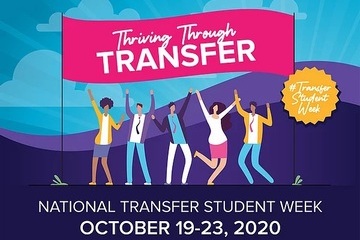
10/12/2020
The COVID-19 pandemic has made the 2020 celebration of National Transfer Student week, Oct. 19 to 23, a virtual one, but the Advisement and Transition staff anticipate a well-attended week of events.
“We are looking forward to students coming and getting excited, especially since this week is made specifically for them,” said organizer Greg Diller ’07, coordinator of transition programs in the Advisement and Transition Office.
Organized nationally by the National Institute for the Study of Transfer Students (NISTS), Transfer Week normally entails many in-person events and hands on activities as well as free giveaways.
This year’s event series, themed on “Thriving Through Transfer,” aims to give transfer students the opportunity to connect with one another and become more comfortable on campus.
Events happening during the week of Oct. 19 to 23 include:
- Monday: SUNY Cortland transfer students are welcome to share information about themselves and their career goals via a virtual board on Kudoboard.com. Career Services will hold a virtual event for transfer students. Information on how to access that event will be released soon.
- Tuesday: Join Transfer Trivia at 6 p.m. via Webex. Battle it out for pride and prizes.
- Wednesday: Listen to the Health Promotion Office’s Wellness Wednesday podcast, “Transitions in College,” via Soundcloud. Students can learn ways to get the help they need as they transition between institutions. The International Programs Office will host a transfer study abroad 101 session at 3 p.m. via Webex.
- Thursday: Tau Sigma National Honor Society Induction Ceremony. The national honor society for transfer students will add its newest members to the SUNY Cortland chapter.
SUNY Cortland’s Advisement and Transition Office will feature faculty and staff members who were transfer students themselves on the office’s social media accounts. Follow on Facebook, Instagram and Twitter to learn more.
To bring this jam-packed week to a close, a slideshow of the Kudoboard posts created by transfer students will be available online.
Even though this celebration only lasts one week, faculty and staff look forward to assisting transfers all year long. These services include academic advising, a COR 201 course for first-year students, new student orientation, transfer credit services and Starfish, a software tool that enhances advising relationships.
Advisors are available via Webex on Wednesdays from 9 a.m. to 3 p.m. and in-person meetings are available by appointment. Call the Advisement and Transition Office at 607-753-4726 for more information.
Diller teaches a COR 201 course that helps guide transfer students. Currently, many transfer students are fully online and haven’t had the opportunity to see the campus yet. During his class he presents virtual tours so students can learn the campus and get to know where the buildings are located.
“The most important thing is to try and stay connected with these 500-plus new students so they know that they are appreciated and that we recognize all of the transitions that they are going through right now,” Diller said. “It’s not easy learning a new school and having to do that mostly virtual is a challenge. Although we’d love to see them this week in person, we can still see each other virtually and we can do it safely and still have fun with it.”
Career Services is an important asset to SUNY Cortland’s transfer students. This office helps in resume building, especially for juniors who will enter into internships or jobs in 2021.
The New York State Transfer and Articulation Association (NYSTAA) complied a lengthy list of ideas on how to celebrate Transfer Week while still staying safe.
SUNY Cortland welcomes approximately 900 new transfer students to campus each year. The number from the Sept. 4 Weekly Enrollment Report was 532 transfer students.
Diller says that it is important that the SUNY Cortland community welcomes its transfer students and supports them.
“There are so many transfer students on campus, more than people even really realize,” Diller said. “Typically, 40% of the incoming population each year are transfer students and the retention rate for transfer students in their first year is 84%, which is higher than first-year retention. Transfer students are just such a big part of what we do here.”
Prepared by Communications Office writing intern Christina Cargulia